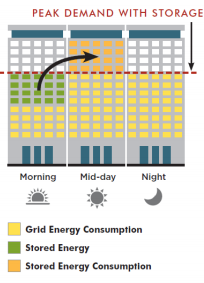 The National Renewable Energy Laboratory (NREL) and Clean Energy Group (CEG) released last week a comprehensive public analysis of U.S. demand charges — the tariffs commercial customers pay to use utility-based electricity in times of high demand — and the potential benefits of demand charge reduction to the millions of customers currently paying premium prices during those peak electricity use periods. Peak demand charges affect not only companies but nonprofits, communities, public buildings, and multi-family housing. In fact, the charges can represent up to 70% of a customer’s utility bill.
The National Renewable Energy Laboratory (NREL) and Clean Energy Group (CEG) released last week a comprehensive public analysis of U.S. demand charges — the tariffs commercial customers pay to use utility-based electricity in times of high demand — and the potential benefits of demand charge reduction to the millions of customers currently paying premium prices during those peak electricity use periods. Peak demand charges affect not only companies but nonprofits, communities, public buildings, and multi-family housing. In fact, the charges can represent up to 70% of a customer’s utility bill.
The newly released study finds that approximately 5 million American businesses now subject to demand charges can achieve significant savings via “peak shaving,” the process of switching to backup storage power — acquired most cost-effectively from a renewable energy microgrid — during periods of high demand, thereby bypassing the tariffs.
Analysis finds significant demand charge reduction
NREL analyzed more than 10,000 utility tariffs throughout the United States and found that more than 5 million of the country’s 18 million commercial customers can reduce their utility bills by using stored energy and that these companies’ would reap cost benefits despite set-up and operation of their alternative energy system. Researchers concluded that cost-effective opportunities for storage exist throughout the country and aren’t limited to environmentally progressive states such as California and New York, but also in the heartland.
“With this analysis, we have identified the areas where customers have the greatest potential to benefit from investments in battery storage,” explains Seth Mullendore, coauthor of the paper and a project director at CEG. “Utilities know where these opportunities exist, and now the rest of us have that information too.”
“Declining costs for energy storage products have created opportunities for commercial customers to deploy batteries to manage peak demand and lower their electricity bills,” adds Joyce McLaren, lead author of the study and a senior energy analyst at NREL. “However, prior to this analysis, no one had performed a comprehensive survey of where the high demand charges are across the country and how many customers might be paying them. Our research seeks to fill that information gap.”
 HOMER DCR models best system for customers to reduce or eliminate demand charges
HOMER DCR models best system for customers to reduce or eliminate demand charges
HOMER Energy’s upcoming DCR (demand charge reduction) tool will help commercial utility customers create the ideal system to achieve the most savings. “The tool performs simulation and optimization analysis,” explains HOMER Energy Director of Energy Engineering John Glassmire, “enabling you to optimize a hybrid energy solution of solar, battery, and generators, so you can use clean technologies to reduce costs and increase reliability. It also allows you to perform sensitivity analysis so you can understand and quantify the robustness of a particular design choice. HOMER DCR performs these calculations with the click of a few buttons.” HOMER DCR is currently in development. Early access will be available in September 2017, with a general availability release to follow. For more information about this tool, see: How to Reduce Utility Bills with Peak Shaving.
